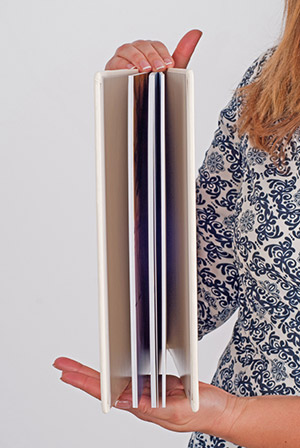Which format should you choose for creating your photo album?
We might be tempted to say that each life event corresponds to a photo album format: besides a clear functional difference, a huge format won't be necessary if you're, for example, creating an album for a child. Conversely, a wedding album should indeed be a large format, to showcase your photos prominently.
In this article we help you choose the size of your photo album. It all depends on what you'll use it for and the cover you choose.
The number of pages to bind in order to create your photo book depends on the format and cover you choose. It ranges from a minimum of 17 to 24 pages, up to an upper limit of 220 to 400.
We recommend, for example, a large format and a padded hard cover for designing a wedding photo album. Our paper is of high quality (200 g/m²).
The A4 Format
The A4 is the most common choice, quite similar to a comic book. It can be easily stored on a bookshelf.
It is the format of all printer sheets and large notebooks used in educational institutions:
- 21X29.7 cm (large portrait).
- 29.7X21 cm (large landscape).
The A5 Format
The A4 allows for a small photo book that's easy to handle for children. It's the ideal photo logbook for travelers or series album enthusiasts. Some create a dozen booklets per year.
The design is simpler and more varied than for a large book:
- 15X21 cm (small portrait).
- 21X15 cm (small landscape).
The Square Format: Order and Originality
It is rarer than the portrait or landscape orientation; it has the effect of deconstructing the usual reading direction.
A square page brings smoothness to a photo book. Photographers advise placing the focal point that will capture the attention in the center of the square.
For aesthetic reasons, a spiral-bound photo album is better suited for these dimensions:
- 21X21 cm (small square).
- 30X30 cm (large square).
Portrait or Landscape Orientation?
To choose the orientation, think about your photo album cover. It will be more decorative with a landscape orientation.
On the other hand, if your book is meant to stay on a shelf, the portrait orientation will be more practical.

Can the Format be Modified?
If you make changes during the work process or just before confirming your book order, know that the proportions of each image or text placement will be preserved.
However, you must flip through the preview before printing to check that the new layout automatically created by our software does not affect the readability of the whole.
Make sure that no image overlaps the "bleed", which is the grey area on the perimeter. It risks being cut off during the manufacturing of your book.
To Learn More: The History of Formats
The Franco-German History of A4 and A5 Formats
When you fold an A4 sheet in half, you get an A5 format. The particularity of these rectangles is that the proportion between the length and width remains unchanged.
This format already existed in France in the 17th century, during the time of Louis XIV. It was legalized in 1798, following the French Revolution, as part of a land registry project. This standard was never applied. It was later adopted in the 19th century by a German standardization institute. These formats have been international standards since 1975.
The Square Shape
In the history of art, the square was the geometrical shape favored at the beginning of the Middle Ages (Romanesque art and Byzantine icons). It contains a round shape with elegance.
Leonard da Vinci made a square and a circle coincide, within which he represented the perfect forms of the human body. Gustav Klimt stood out with his painting The Kiss in a square format. Then Malevich painted a white square on a white background using two different origin whites, one bluish and the other ochre.
Many contemporary artists have used the square shape, don't hesitate to draw inspiration for your graphics and patterns offered by our online editing software, available on our website for creating photo books.
Also read:
- 5 Tips for Easily Creating a Photo Album on a Website
- Our advice to create an original photo album
- Create a Spiral Photo Album like the professionals
- Pro Tips for Designing Your Photo Book Cover
- Print Your Photo Book Like a Professional
- 6 Ideas for an Original and Personalized Photo Book
- Our Advice for Creating a Photo Album Keepsake
- How to design a photo book layout for maximum impact
- What is the best paper for your photo book?
- Our Advice for Choosing the Right Format for Your Photo Book
- What is the ideal image resolution for your photo book?
- The Ratio Between Text and Image in a Photo Album
- The binding of your photo book, quite a science!
- Tips to Improve Your Photo Album Quality
- Our tips for editing photos for your photo book
- Six Tips to Succeed With Your Personalized Photo Album
